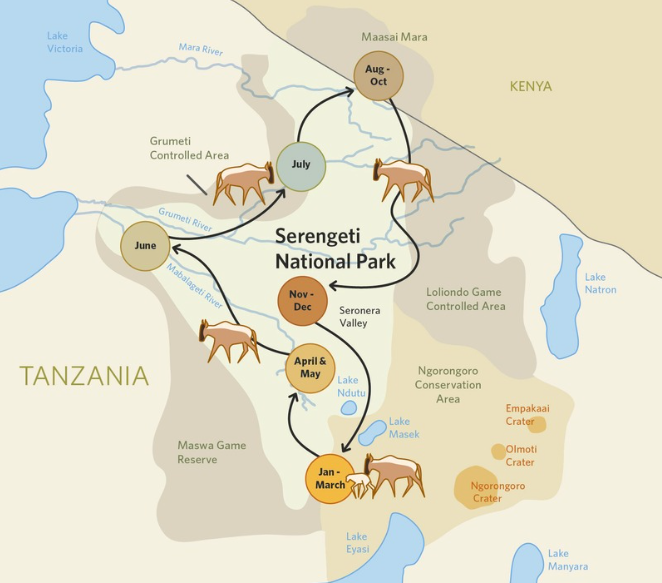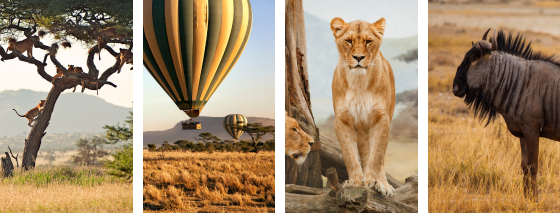Safari Myth Busters: 5 Surprising Truths About Kenya and Tanzania
Last month you read about Daphnée’s recent trip to Kenya. In 2023, I had one of my favourite travel experiences in Tanzania and fell in love with the country. The wildlife is abundant, the landscapes are magnificent, and the people are warm and friendly – the perfect ingredients to make any trip one that you’ll remember forever. Read more about my Tanzania trip here.
Here are 5 myths about going on safari in East Africa. If you’ve ever been, let me know if you agree!
1. The Great Wildebeest Migration only happens between August and October
The wildebeest follow the rains in a year-round circular journey. The short rains start in early November. By late November and December, the herds of migrating wildebeest reach the short-grass plains of the Serengeti. They remain here through January, February, and March, with most calves born in a short window around February.
By May, the wildebeest in the Serengeti move north, migrating to seek fresh grazing and water. The area around Moru Kopjes and west of Seronera is busy at this time.
Around June the wildebeest migration is often halted on the south side of the Grumeti River, which has some channels that block, or slow, their migration north. They congregate in the Western Corridor, often building up to a high density before crossing the river. The migration continues moving northwards during July and August, often spreading out across a broad front: some head through Grumeti Reserve and Ikorongo, others north through the heart of the Serengeti National Park.
September sees the herds spread out across the northern Serengeti, where the Mara River provides the migration with its most serious obstacle. This river crossing is the most famous and brings a lot of drama.
By October, the wildebeest begin moving south again, returning to the short-grass plains of the southern Serengeti in November, before starting the cycle all over again.

2. There’s no wildlife to see outside of the migration area
There is excellent resident wildlife throughout the Serengeti and Masai Mara and some of the most rewarding safaris are to be had outside of the migration when there are fewer crowds and one can truly experience the wilderness of Africa. You will see magnificent big cats, elephants, antelope, birds and reptiles all year round. The green season (April and May) is great for enjoying lush green landscapes and photography is superb.
3. You can easily drive between the Serengeti and Masai Mara
It’s not very easy to cross by road from the northern Serengeti, which is in Tanzania, into the Masai Mara, which is in Kenya. The best option is to fly. You need to depart from an international airport in the Serengeti, and land at an airstrip in Kenya where you can get your passport stamped. Commonly used airstrips are Kogatende and Seronera in Tanzania and Keekorok Airstrip in the Masai Mara.
4. It’s always hot on safari in East Africa
This is a myth! Travelling to national parks at a high altitude, such as Ngorongoro Crater and Amboseli, can get quite cold in the evenings. Bring something warm to wear and remember, layers work best when planning outfits.
5. The only national parks worth visiting in East Africa are the Serengeti and Masai Mara.
Absolutely not! There are incredible national parks, rich in biodiversity and sensational landscapes throughout Tanzania and Kenya. The Ngorongoro Crater is exquisitely beautiful, and southern Tanzania has much to offer visitors –- for instance, parks like Ruaha and Nyere National Park. Kenya has an equally dazzling array of national parks to choose from, such as Amboseli, Lake Nakuru and Samburu.

No matter if you want to see stampeding herds of wildebeest, visit Maasai tribes, or be immersed in the wonder of the concentration of wildlife in the Ngorongoro Crater we will gladly guide you in building a tailored itinerary suited just to you.
Happy Travelling,
Diana


